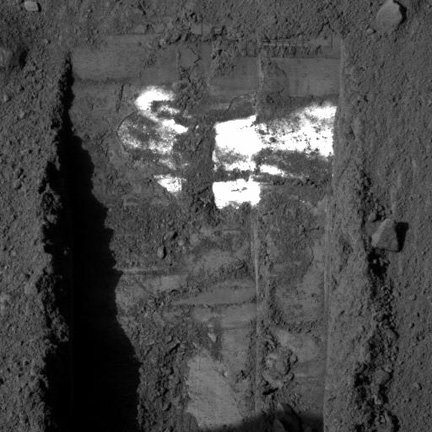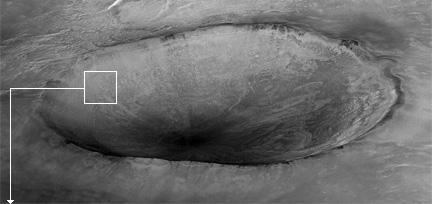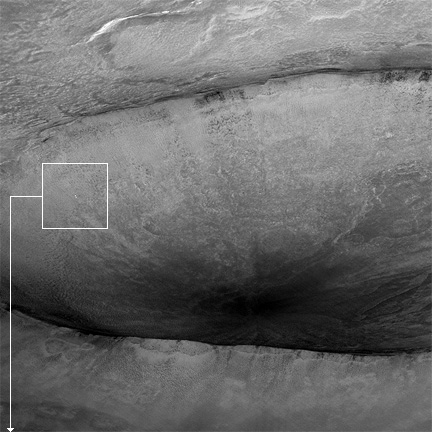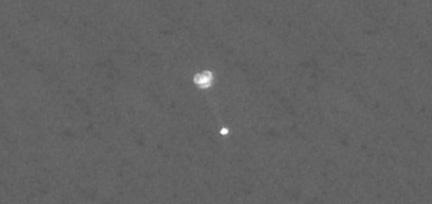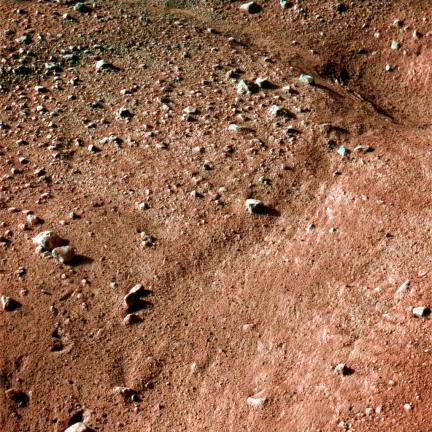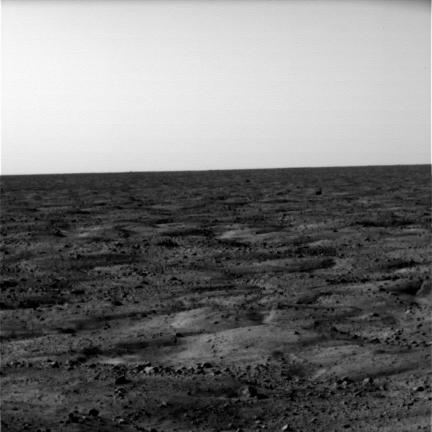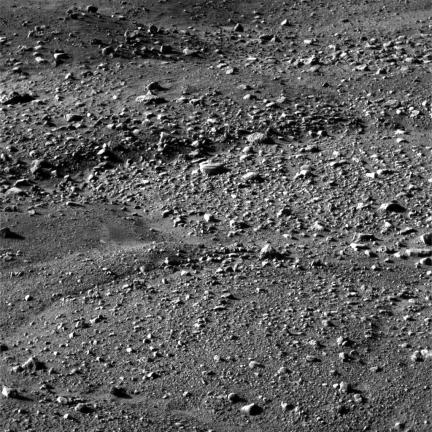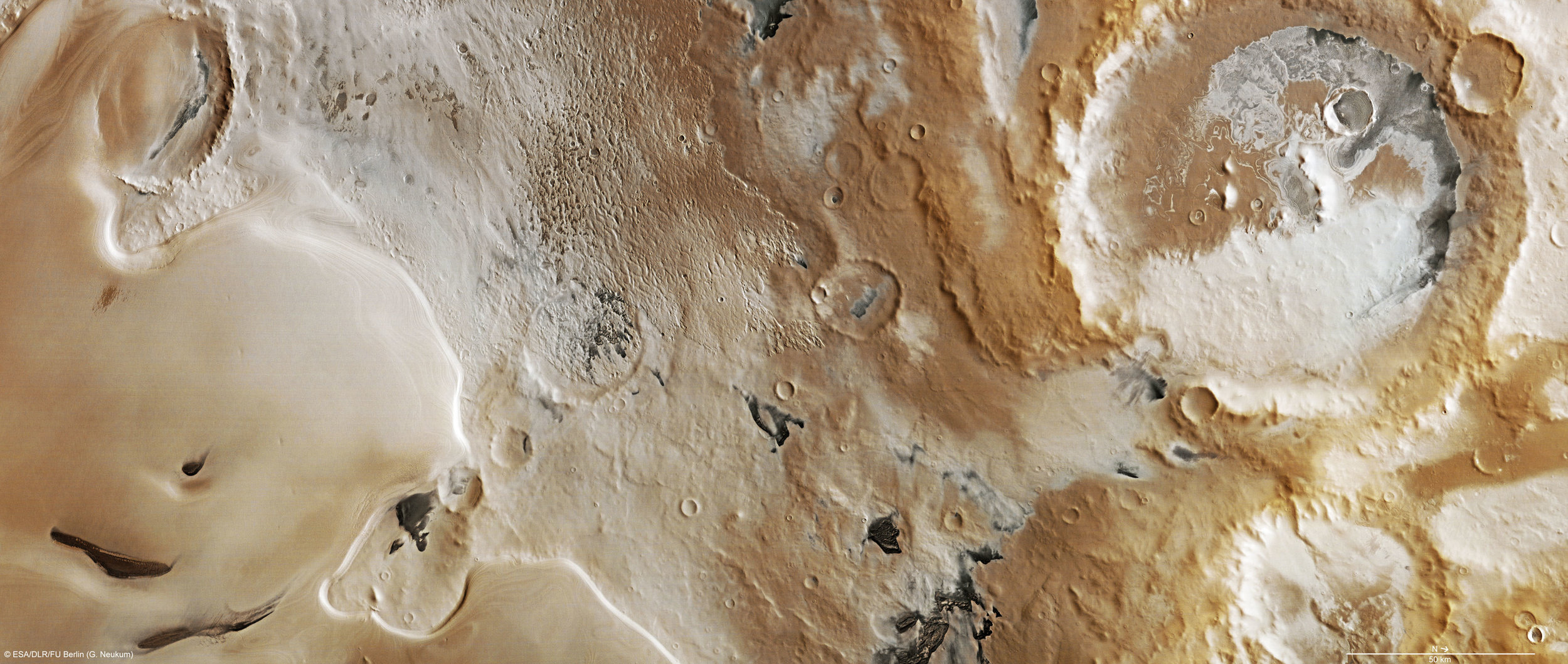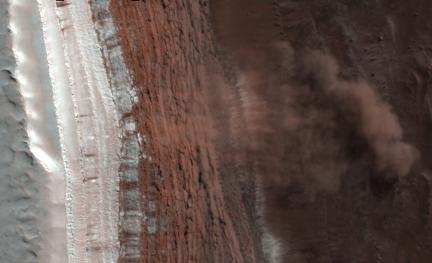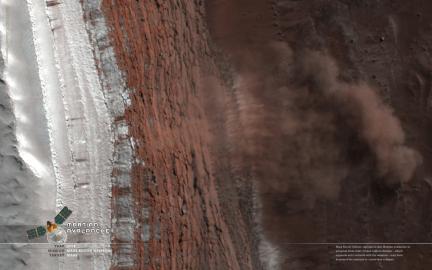What is on Phoenix’s Leg?
 I cannot stop looking at this animation. The first frame was taken on the 8th sol (a Mars day) and the second around the 31st sol. As you can see from the animation, it seems that some mystery material is either growing, moving or multiplying around one of the legs of the Phoenix lander. The most likely source is frost building up on what would be a very cold surface, however the only issue is that it doesn’t look exactly like frost and it hasn’t appeared on any of the other legs.
I cannot stop looking at this animation. The first frame was taken on the 8th sol (a Mars day) and the second around the 31st sol. As you can see from the animation, it seems that some mystery material is either growing, moving or multiplying around one of the legs of the Phoenix lander. The most likely source is frost building up on what would be a very cold surface, however the only issue is that it doesn’t look exactly like frost and it hasn’t appeared on any of the other legs.
Image note: We added an artificial fade from 1 frame to frame 2 and scaled the original image to around 300%. Due to artifacts from increasing the scale and compression we added some noise to smooth out the overall appearance.
Martian Soil Could Support Life
 It looks like Phoenix is finding results with chemistry analysis tests that suggest Martian soil could - or could have supported life. We have known for a while now that elements like magnesium, sodium, potassium and chlorine are all found in Martian soil. Now we also know that the soil alkalinity is comparable to that which we grow all kinds of plants in here on Earth.
It looks like Phoenix is finding results with chemistry analysis tests that suggest Martian soil could - or could have supported life. We have known for a while now that elements like magnesium, sodium, potassium and chlorine are all found in Martian soil. Now we also know that the soil alkalinity is comparable to that which we grow all kinds of plants in here on Earth.
There are more tests to be done, but these results could make growing vegetables in Martian soil a reality one day. It also makes it more conceivable that some kind of life may one day have existed on Mars… or even currently.
The Phoenix Ice Melt
 Thank you… its just what we came for. Now, can we have that in a glass or perhaps with some bacteria?
Thank you… its just what we came for. Now, can we have that in a glass or perhaps with some bacteria?
Phobos Hangs Above the Martian Horizon
Was reminded of this image in the current issue of The Planetary Report. It was taken by Mars Express in 2007 and is featured in a current article about the excellent Russian Phobos-Grunt mission planned for 2009. This mission marks a return to planetary exploration for the Russian space program and does so in a big way. The plan is to land on the Martian moon Phobos – take samples of its surface and return them back to Earth. Sample return missions are technically very difficult and in all of history the number of attempts numbers in the single digits.
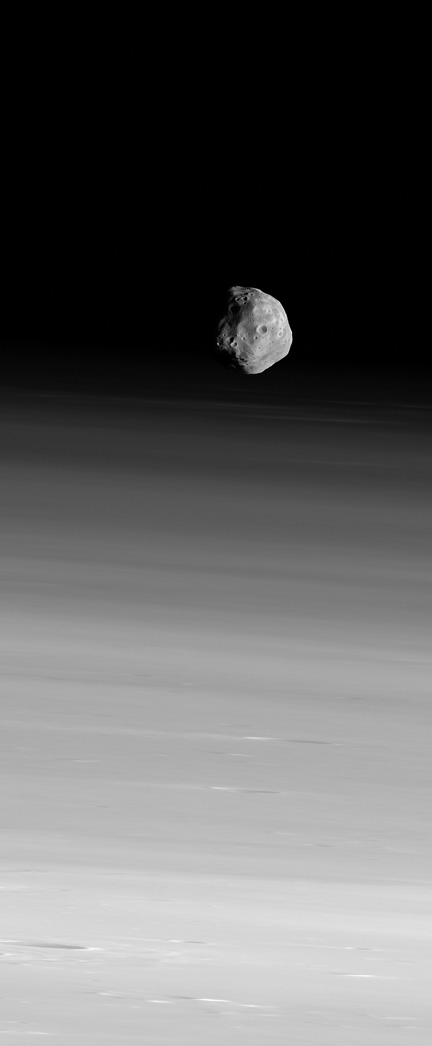
Pssst… Look Under Your Feet
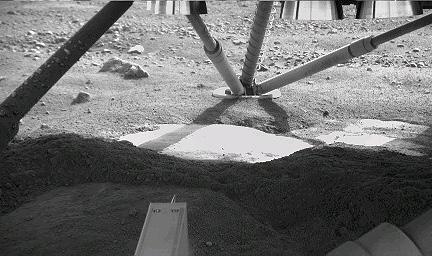 The Mars Phoenix Lander was sent on its long mission to Mars for really one purpose: to find ice. The region selected was seen as one of the more likely places on Mars to have an ice table that is closer to the surface and hopefully available to its robotic arm deployed just a few days ago.
The Mars Phoenix Lander was sent on its long mission to Mars for really one purpose: to find ice. The region selected was seen as one of the more likely places on Mars to have an ice table that is closer to the surface and hopefully available to its robotic arm deployed just a few days ago.
The above image was taken yesterday by that robotic arm and lead scientists suspect that the bright patch visible in the image is the very ice they have been looking for. It would seem that when Phoenix’s thrusters were fired to slow the lander down for a soft touch-down – that all the dust and soil below it was blown away to reveal a smooth and highly reflective surface.
It is not yet official… but this could mean mission accomplished for Phoenix.
Phoenix Landing Site as Seen by Mars Recon
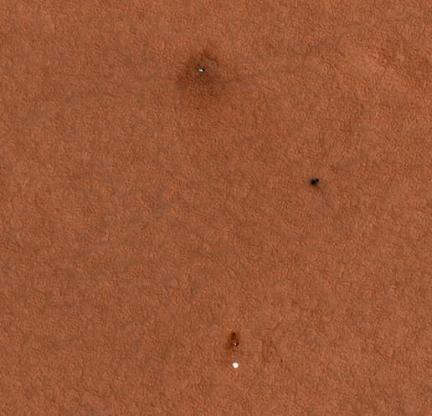 So much for descent images… here is Phoenix in its resting place also taken by Mars Recon. Seen here is the lander on top, the heat shield (with a bounce mark) and the parachute below (which appears to have fallen nicely elongated).
So much for descent images… here is Phoenix in its resting place also taken by Mars Recon. Seen here is the lander on top, the heat shield (with a bounce mark) and the parachute below (which appears to have fallen nicely elongated).
The Phoenix Landing Image in Context
Near True Color From Phoenix
 Near “true” color made by Gordan Ugarkovic using the only RED, GREEN and BLUE filtered images returned from the mission thus far. Additional adjustments were made by looking at the logo and the American flag (which we have an idea of what those color are supposed to look like) and adjusting the color of those items to appear as what we know are “true colors”. Logic then dictates that if those items are correctly balanced, then the Martian soil will also appear close to accurate.
Near “true” color made by Gordan Ugarkovic using the only RED, GREEN and BLUE filtered images returned from the mission thus far. Additional adjustments were made by looking at the logo and the American flag (which we have an idea of what those color are supposed to look like) and adjusting the color of those items to appear as what we know are “true colors”. Logic then dictates that if those items are correctly balanced, then the Martian soil will also appear close to accurate.
Phoenix Landing as Seen by Mars Recon
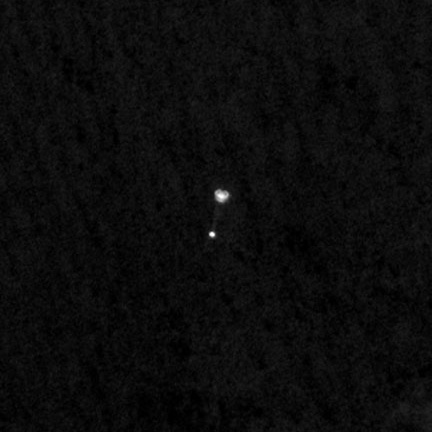 This image represents the very first time we have been able to acquire a visual on any kind of probe landing on the surface of another moon/planet. What is (clearly) seen here is the Mars Phoenix lander in the parachute phase of its descent. You can even make out the shape of the thin threads that hold Phoenix tethered to its chute.
This image represents the very first time we have been able to acquire a visual on any kind of probe landing on the surface of another moon/planet. What is (clearly) seen here is the Mars Phoenix lander in the parachute phase of its descent. You can even make out the shape of the thin threads that hold Phoenix tethered to its chute.
Normally a visit to another world is a solitary experience, but as many as 3 other probes already in orbit around Mars (Mars Reconnaissance, Mars Express and Mars Odyssey) were timed out to be in the general overhead vicinity of the Phoenix landing. It just so happens that one of them, Mars Recon, has very sharp eyes.
False Color From Phoenix
First Images From Phoenix
This mission is not likely to be very exciting in the imaging. So far most of what has been returned looks more like the more ordinary images returned by the Mars Rovers. The real excitement of this mission is drilling for the water ice. The first images are look a whole lot like an old moon mission from the early sixties:

The horizon from Phoenix. You can now see the features that made up the cantaloupe-like texture of the images of this region from orbit.
Phoenix is on Martian Ground
Area Where Phoenix is Expected to Land
 See also.
See also.
Phoenix Lands in 3 Days
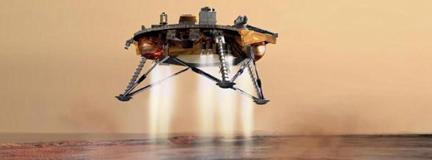 Official website is here and the official blog.
Official website is here and the official blog.
Mars Phoenix: May 25th Landing Site
 Getting ready for the next Martian visitor!
Getting ready for the next Martian visitor!
This image is taken within the region that Mars Phoenix is expected to land on May 25th, one month from today. The whitish areas criss-crossing the landscape here is the seasonal carbon dioxide frost that covers the Martian poles during the winter. Phoenix will represent the first ever landing in a Martian polar region and is expected to yield considerably different results than we have seen from any of the previous landers or rovers.
Hebes Chasma in Valles Marineris
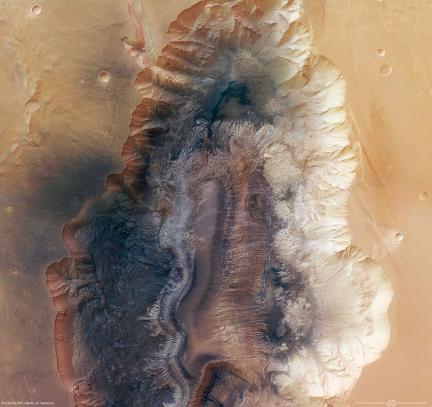 I have been very busy lately… this is from the Mars Express site, “Hebes Chasma is an enclosed trough, almost 8000 m deep, in Valles Marineris, the Grand Canyon of Mars, where water is believed to have flowed. The High Resolution Stereo Camera (HRSC) on ESA’s Mars Express studied the area providing new pictorial clues to its history.”
I have been very busy lately… this is from the Mars Express site, “Hebes Chasma is an enclosed trough, almost 8000 m deep, in Valles Marineris, the Grand Canyon of Mars, where water is believed to have flowed. The High Resolution Stereo Camera (HRSC) on ESA’s Mars Express studied the area providing new pictorial clues to its history.”
Mars: Promethei Planum
Martian Avalanche!
 In the referential image above, two avalanches were captured in action by the Mars Reconnaissance Orbiter. The larger of these two (B) is around 180 meters wide, extends about 190 meters and the cliff heights are around 700 meters tall. The White material on the top that appears as snow is actually carbon dioxide frost which is currently receding as the Martian Spring moves closer. It is this very process which may be the cause of such falls as the carbon dioxide frost expands and contracts with the changing seasonal temperatures. Despite these seasonal changes, most areas of the Martian surface have likely been unchanged for millions of years, so it is quite rare to capture such cataclysmic activities in a single image from orbit.
In the referential image above, two avalanches were captured in action by the Mars Reconnaissance Orbiter. The larger of these two (B) is around 180 meters wide, extends about 190 meters and the cliff heights are around 700 meters tall. The White material on the top that appears as snow is actually carbon dioxide frost which is currently receding as the Martian Spring moves closer. It is this very process which may be the cause of such falls as the carbon dioxide frost expands and contracts with the changing seasonal temperatures. Despite these seasonal changes, most areas of the Martian surface have likely been unchanged for millions of years, so it is quite rare to capture such cataclysmic activities in a single image from orbit.
IMAGE NOTE: The images above are listed as RGB, but the accompanying text describes all the images as “false color”. Guess – maybe it means the colors are natural but exaggerated? See below for 1440x900 landscape wallpaper.
Mars: Basal Unit and Dunes
 A recent post on unmannedspaceflight.com inquired “What’s your favorite view of the poles?” and Philip Descarfino (who did the colorization work) responded with the above image. According to Philip, “I find this image one of the best of HiRise so far. You really get the feeling of staring off into the distance from just above the surface instead of looking directly downward. It's mostly an illusion, but it works quite well in this image.”
A recent post on unmannedspaceflight.com inquired “What’s your favorite view of the poles?” and Philip Descarfino (who did the colorization work) responded with the above image. According to Philip, “I find this image one of the best of HiRise so far. You really get the feeling of staring off into the distance from just above the surface instead of looking directly downward. It's mostly an illusion, but it works quite well in this image.”
NOTE: Technically the image itself is interpretive in that it is not an RGB composite but instead a colorized black and white image based upon other color images from the same region. Usually you can almost tell from a glance when this is done, but this one looks spot on.
